Rural Migration and Urbanization in China: Historical Evolution and Coupling Pattern
Abstract
1. Introduction
2. Materials and Methods
2.1. Materials
2.2. Methods
2.2.1. Measurement of Rural Migration and Urbanization
2.2.2. Coupling Coordination Degree Model
2.2.3. Spatial Autocorrelation Analysis
3. Results and Analysis
3.1. Rural Migration and Urbanization in China
3.1.1. Recovery and Development Stage (1978~1995)
3.1.2. Stable and Rapid Development Stage (1995~2014)
3.1.3. Stage of Promoting Citizenization of Rural Migrant Population (2014~2017)
3.2. Spatial Patterns of Rural Migration and Urbanization
3.3. Coupling Pattern of Rural Migration and Urbanization
4. Discussion
4.1. Results Discussion
4.2. Rural Migration and Urbanization
5. Conclusions and Policy Implications
Author Contributions
Funding
Acknowledgments
Conflicts of Interest
References
- Wang, D. The design of a social security system for rural migrant workers in China. In Migration and Social Protection in China; World Scientific: London, UK, 2008. [Google Scholar]
- Williamson, J.G. Chapter 11 Migration and urbanization. In Handbooks in Economics; Elsevier: Amsterdam, The Netherlands, 1988; Volume 1, pp. 425–465. [Google Scholar]
- Chan, K.W. The Household Registration System and Migrant Labor in China: Notes on a Debate. Popul. Dev. Rev. 2010, 36, 357–364. [Google Scholar] [CrossRef] [PubMed]
- Wu, X.; Treiman, D.J. The household registration system and social stratification in China: 1955-1996. Demography 2004, 41, 363–384. [Google Scholar] [CrossRef] [PubMed]
- Guo, Y.; Zhou, Y.; Liu, Y. Spatial-temporal evolution of rural population outflow and its mechanism in China. Sci. Geogr. Sinica 2020, 40, 50–59. [Google Scholar]
- Normile, D. China’s living laboratory in urbanization. Science 2008, 319, 740–743. [Google Scholar] [CrossRef]
- Bai, X.; Shi, P.; Liu, Y. Realizing China’s urban dream. Nature 2014, 509, 158–160. [Google Scholar] [CrossRef]
- Li, J.; Deng, J.; Wang, K.; Li, J.; Huang, T.; Lin, Y.; Yu, H. Spatiotemporal Patterns of Urbanization in a Developed Region of Eastern Coastal China. Sustainability 2014, 6, 4042–4058. [Google Scholar] [CrossRef]
- National Bureau of Statistics of China. Statistical Communiqué of the People’s Republic of China on the 2017 National Economic and Social Development. Available online: http://www.stats.gov.cn/english/PressRelease/201802/t20180228_1585666.html (accessed on 28 February 2018).
- Liu, Y.; Li, J.; Yang, Y. Strategic adjustment of land use policy under the economic transformation. Land Use Policy 2018, 74, 5–14. [Google Scholar] [CrossRef]
- Lewis, W.A. Economic development with unlimited supplies of labor. Manch. Sch. 1954, 22, 139–191. [Google Scholar] [CrossRef]
- Jorgenson, D.W. The Development of a Dual Economy. Econ. J. 1961, 71, 309. [Google Scholar] [CrossRef]
- Ranis, G.; Fei, J.C.H. A theory of economic development. Am. Econ. Rev. 1961, 51, 533–565. [Google Scholar]
- Kelley, A.C.; Williamson, J.G.; Cheetham, R.J. Dualistic Economic Development: Theory and History; University of Chicago Press: Chicago, IL, USA, 1972. [Google Scholar]
- Todaro, M.P. A model of labor migration and urban unemployment in less developed countries. Am. Econ. Rev. 1969, 59, 138–148. [Google Scholar]
- Harris, J.R.; Todaro, M.P. Migration, unemployment and development: A two-sector analysis. Am. Econ. Rev. 1970, 60, 126–142. [Google Scholar]
- Corden, W.M.; Findlay, R. Urban Unemployment, Intersectoral Capital Mobility and Development Policy. Economica 1975, 42, 59. [Google Scholar] [CrossRef]
- Fang, C.; Liu, H.; Li, G.; Sun, D.; Miao, Z. Estimating the Impact of Urbanization on Air Quality in China Using Spatial Regression Models. Sustainability 2015, 7, 15570–15592. [Google Scholar] [CrossRef]
- Deng, X.; Huang, J.; Rozelle, S.; Zhang, J.; Li, Z. Impact of urbanization on cultivated land changes in China. Land Use Policy 2015, 45, 1–7. [Google Scholar] [CrossRef]
- Davis, K. The Urbanization of the Human Population. Sci. Am. 1965, 213, 40–53. [Google Scholar] [CrossRef]
- Chen, Q.; Song, Z. Accounting for China’s urbanization. China Eco. Rev. 2014, 30, 485–494. [Google Scholar] [CrossRef]
- He, C.; Chen, T.; Mao, X.; Zhou, Y. Economic transition, urbanization and population redistribution in China. Habitat Int. 2016, 51, 39–47. [Google Scholar] [CrossRef]
- Zhang, J. Urbanization, population transition, and growth. Oxf. Econ. Pap. 2002, 54, 91–117. [Google Scholar] [CrossRef]
- Qian, J.; Peng, Y.; Luo, C.; Wu, C.; Du, Q. Urban Land Expansion and Sustainable Land Use Policy in Shenzhen: A Case Study of China’s Rapid Urbanization. Sustainability 2015, 8, 16. [Google Scholar] [CrossRef]
- Chen, J.; Chang, K.-T.; Karácsonyi, D.; Zhang, X. Comparing urban land expansion and its driving factors in Shenzhen and Dongguan, China. Habitat Int. 2014, 43, 61–71. [Google Scholar] [CrossRef]
- Martinuzzi, S.; Gould, W.A.; González, O.M.R. Land development, land use, and urban sprawl in Puerto Rico integrating remote sensing and population census data. Landsc. Urban. Plan. 2007, 79, 288–297. [Google Scholar] [CrossRef]
- People. New Characteristics of Population Migration and Urbanization in China. Available online: http://politics.people.com.cn/n/2013/0204/c70731-20426975.html (accessed on 4 February 2013).
- O’Brien, P.K. Path dependency, or why Britain became an industrialized and urbanized economy long before France. Econ. Hist. Rev. 1996, 49, 213–249. [Google Scholar] [CrossRef]
- Knight, J.; Deng, Q.; Li, S. The puzzle of migrant labor shortage and rural labor surplus in China. China Econ. Rev. 2011, 22, 585–600. [Google Scholar] [CrossRef]
- Regmi, A.; Dyck, J. Effects of urbanization on global food demand. In Changing Structure of Global Food Consumption and Trade; US Department of Agriculture: Washington, DC, USA, 2001. [Google Scholar]
- Quigley, J.M. Urbanization, agglomeration, and economic development. In Urbanization and Growth; Palgrave Macmillan: London, UK, 2009. [Google Scholar]
- Henderson, J.V.; Wang, H.G. Aspects of the rural-urban transformation of countries. J. Econ. Geogr. 2005, 5, 23–42. [Google Scholar] [CrossRef]
- Feser, E.; Isserman, A. Harnessing growth spillovers for rural development: The effects of regional spatial structure. In Report to USDA Rural Development; University of Illinois at Urbana-Champaign: Champaign, IL, USA, 2006. [Google Scholar]
- Liu, Y.; Li, Y. Revitalize the world’s countryside. Nature 2017, 548, 275–277. [Google Scholar] [CrossRef]
- Chen, M.; Liu, W.; Lu, D. Challenges and the way forward in China’s new-type urbanization. Land Use Policy 2016, 55, 334–339. [Google Scholar] [CrossRef]
- Jiao, L.; Shen, L.; Shuai, C.; He, B. A Novel Approach for Assessing the Performance of Sustainable Urbanization Based on Structural Equation Modeling: A China Case Study. Sustainability 2016, 8, 910. [Google Scholar] [CrossRef]
- Johnson, L. Bordering Shanghai: China’s hukou system and processes of urban bordering. Geoforum 2017, 80, 93–102. [Google Scholar] [CrossRef]
- Seeborg, M.C.; Jin, Z.; Zhu, Y. The new rural-urban labor mobility in China: Causes and implications. J. Socio-Econ. 2000, 29, 39–56. [Google Scholar] [CrossRef]
- Chen, C.; Fan, C.C. Rural-urban circularity in China: Analysis of longitudinal surveys in Anhui, 1980–2009. Geoforum 2018, 93, 97–104. [Google Scholar] [CrossRef]
- Li, L.-H. Balancing Rural and Urban Development: Applying Coordinated Urban–Rural Development (CURD) Strategy to Achieve Sustainable Urbanisation in China. Sustainability 2017, 9, 1948. [Google Scholar] [CrossRef]
- Liu, Y.; Liu, Y.; Chen, Y.; Long, H. The process and driving forces of rural hollowing in China under rapid urbanization. J. Geogr. Sci. 2010, 20, 876–888. [Google Scholar] [CrossRef]
- Wang, X.; Hui, E.C.-M.; Choguill, C.; Jia, S.-H. The new urbanization policy in China: Which way forward? Habitat Int. 2015, 47, 279–284. [Google Scholar] [CrossRef]
- National Bureau of Statistics of China. China Population Statistics Yearbook; China Statistics Press: Beijing, China, 1988–2006.
- National Bureau of Statistics of China. China population and employment statistics yearbook; China Statistics Press: Beijing, China, 2007–2018.
- Population Census Office under the State Council, National Bureau of Statistics of China. Tabulation on the 2000/2010 Population Census of the People’s Republic of China by county; China Statistics Press: Beijing, China, 2012. [Google Scholar]
- Resource and Environment Data Cloud Platform. Data on China’s Administrative Division. Available online: http://www.resdc.cn/Datalist1.aspx?FieldTyepID=20,0 (accessed on 4 February 2017).
- National Bureau of Statistics of China. Division Method of Eastern, Western, Central, and Northeastern China. Available online: http://www.stats.gov.cn/ztjc/zthd/sjtjr/dejtjkfr/tjkp/201106/t20110613_71947.htm (accessed on 13 June 2011).
- de Walle, E.V. Multilingual Demographic Dictionary (English Section); International Union for the Scientific Study of Population (IUSSP): Liege, Belgium, 1982. [Google Scholar]
- Guo, Y.; Zhou, Y.; Cheng, T.; Liu, Y. Deconstruction and regional divisions of population urbanization at county level in Zhejiang Province. Econ. Geogr. 2018, 38, 63–71. [Google Scholar]
- Valerie, I. The penguin dictionary of physics; Foreign Language Press: Beijing, China, 1996. [Google Scholar]
- Li, Y.; Li, Y.; Zhou, Y.; Shi, Y.; Zhu, X. Investigation of a coupling model of coordination between urbanization and the environment. J. Environ. Manag. 2012, 98, 127–133. [Google Scholar] [CrossRef] [PubMed]
- Ding, L.; Zhao, W.; Huang, Y.; Cheng, S.; Liu, C. Research on the Coupling Coordination Relationship between Urbanization and the Air Environment: A Case Study of the Area of Wuhan. Atmosphere 2015, 6, 1539–1558. [Google Scholar] [CrossRef]
- Lu, J.; Guo, Z. The evolution of coupling relationship between population migration and economic growth in China. Popul. Res. 2014, 38, 40–56. [Google Scholar]
- Tang, Z. An integrated approach to evaluating the coupling coordination between tourism and the environment. Tour. Manag. 2015, 46, 11–19. [Google Scholar] [CrossRef]
- Tobler, W.R. A Computer Movie Simulating Urban Growth in the Detroit Region. Econ. Geogr. 1970, 46, 234. [Google Scholar] [CrossRef]
- Cliff, A.D.; Ord, J.K. Spatial Processes: Models and Applications; Pion Ltd.: London, UK, 1981. [Google Scholar]
- Anselin, L. Local Indicators of Spatial Association-LISA. Geogr. Anal. 2010, 27, 93–115. [Google Scholar] [CrossRef]
- Oi, J.C. The role of the local state in China’s transitional economy. China Quart. 1995, 144, 1132–1149. [Google Scholar] [CrossRef]
- Chan, K.W.; Zhang, L. The “hukou” system and rural-urban migration in China: Processes and changes. China Q. 1999, 160, 818–855. [Google Scholar] [CrossRef] [PubMed]
- Chan, K.W. The ChineseHukouSystem at 50. Eurasian Geogr. Econ. 2009, 50, 197–221. [Google Scholar] [CrossRef]
- Cai, F. Hukou System Reform and Unification of Rural-urban Social Welfare. China World Econ. 2011, 19, 33–48. [Google Scholar] [CrossRef]
- The State Council the People’s Republic of China. National New-Type Urbanization Plan (2014-2020) Issued by the CPC Central Committee and the State Council. Available online: http://www.gov.cn/gongbao/content/2014/content_2644805.htm?76 (accessed on 16 March 2014).
- Ravenstein, E.G. The Laws of Migration. J. Stat. Soc. Lond. 1885, 48, 167. [Google Scholar] [CrossRef]
- Waldinger, R. Immigration and urban change. Annu. Rev. Sociol. 1989, 15, 211–232. [Google Scholar] [CrossRef]
- Baldwin, R.E. Patterns of Development in Newly Settled Regions. Manch. Sch. 1956, 24, 161–179. [Google Scholar] [CrossRef]
- Zhang, K.H.; Song, S. Rural–urban migration and urbanization in China: Evidence from time-series and cross-section analyses. China Econ. Rev. 2003, 14, 386–400. [Google Scholar] [CrossRef]
- Lee, E.S. A Theory of Migration. Demography 1966, 3, 47–57. [Google Scholar] [CrossRef]
- King, R. Geography and Migration Studies: Retrospect and Prospect. Popul. Space Place 2011, 18, 134–153. [Google Scholar] [CrossRef]
- Abel, G.J.; Sander, N. Quantifying Global International Migration Flows. Science 2014, 343, 1520–1522. [Google Scholar] [CrossRef] [PubMed]
- Okun, B.; Richardson, R.W. Regional Income Inequality and Internal Population Migration. Econ. Dev. Cult. Chang. 1961, 9, 128–143. [Google Scholar] [CrossRef]
- Shrestha, N.R. Institutional policies and migration behavior: A selective review. World Dev. 1987, 15, 329–345. [Google Scholar] [CrossRef]
- Chen, T.; Chen, C. Coupling evaluation of urbanization and rural population hollowing at county level under the background of population outflow. Issues Agr. Econ. 2017, 4, 60–68. [Google Scholar]
- Gibbs, J.P. The Evolution of Population Concentration. Econ. Geogr. 1963, 39, 119. [Google Scholar] [CrossRef]
- Puga, D. Urbanization patterns: European versus less developed countries. J. Reg. Sci. 1998, 38, 231–252. [Google Scholar] [CrossRef]
- Njoh, A.J. Urbanization and development in sub-Saharan Africa. Cities 2003, 20, 167–174. [Google Scholar] [CrossRef]
- Cohen, B. Urbanization in developing countries: Current trends, future projections, and key challenges for sustainability. Technol. Soc. 2006, 28, 63–80. [Google Scholar] [CrossRef]
- Chan, K.W. Urbanization and Rural- Urban Migration in China since 1982. Mod. China 1994, 20, 243–281. [Google Scholar] [CrossRef]
- Long, H.; Zou, J.; Liu, Y. Differentiation of rural development driven by industrialization and urbanization in eastern coastal China. Habitat Int. 2009, 33, 454–462. [Google Scholar] [CrossRef]
- Guo, Y.; Xiao, Y.; Yuan, Q. The redevelopment of peri-urban villages in the context of path-dependent land institution change and its impact on Chinese inclusive urbanization: The case of Nanhai, China. Cities 2017, 60, 466–475. [Google Scholar] [CrossRef]
- Yang, F. The study of social exclusion problem for migrant workers. J. East China U. Sci. Techn. (Soc. Sci. Edit.) 2014, 29, 87–92. [Google Scholar]
- Long, H.; Li, Y.; Liu, Y.; Woods, M.; Zou, J. Accelerated restructuring in rural China fueled by ‘increasing vs. decreasing balance’ land-use policy for dealing with hollowed villages. Land Use Policy 2012, 29, 11–22. [Google Scholar] [CrossRef]
- Wei, H.; Su, H. Study on the process of citizenization of agricultural transfer population in China. Chin. J. Popul. Sci. 2013, 5, 21–29. [Google Scholar]
- State Information Center. The history and future trend of urbanization in China. Available online: http://www.sic.gov.cn/News/455/6167.htm (accessed on 8 April 2016).
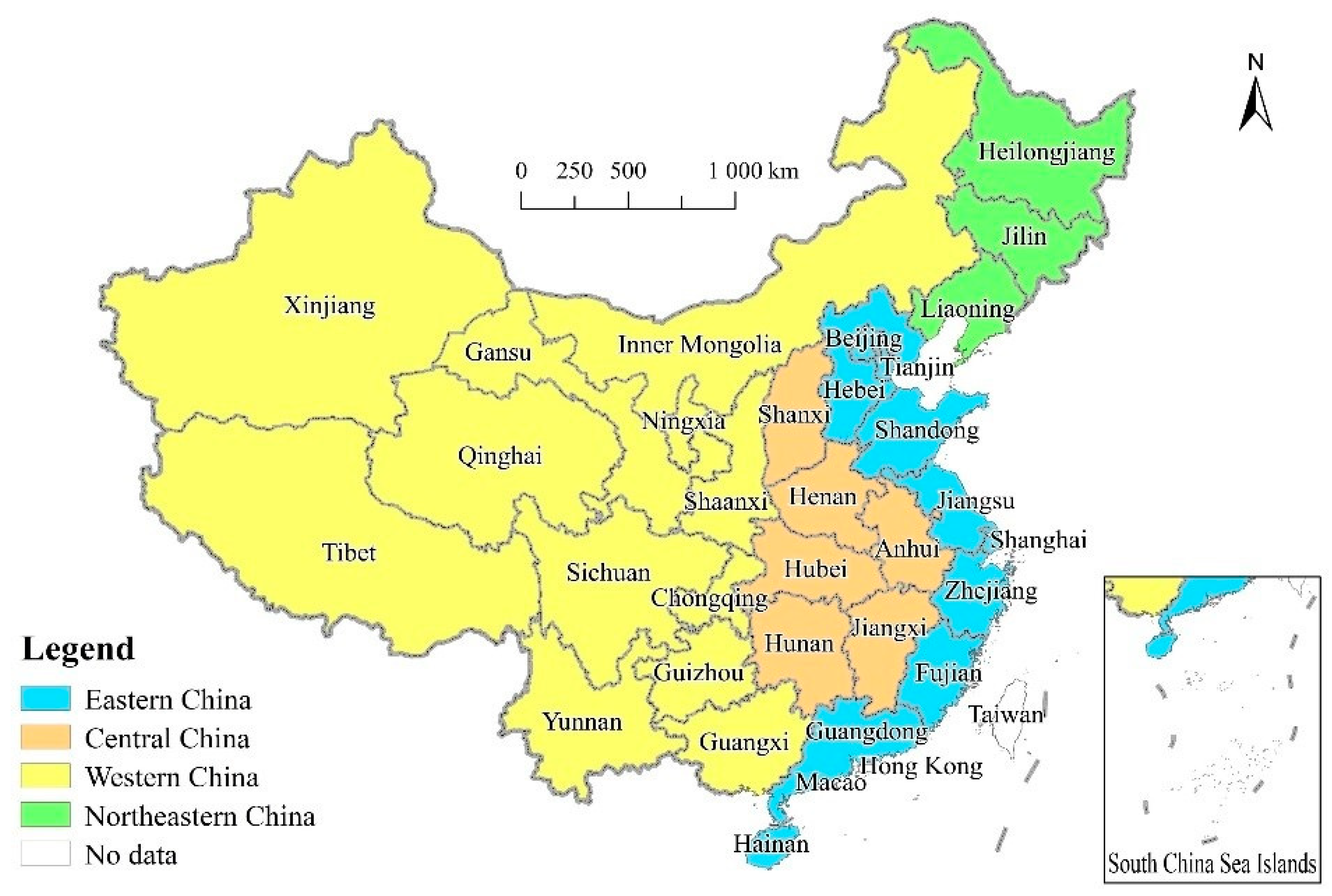
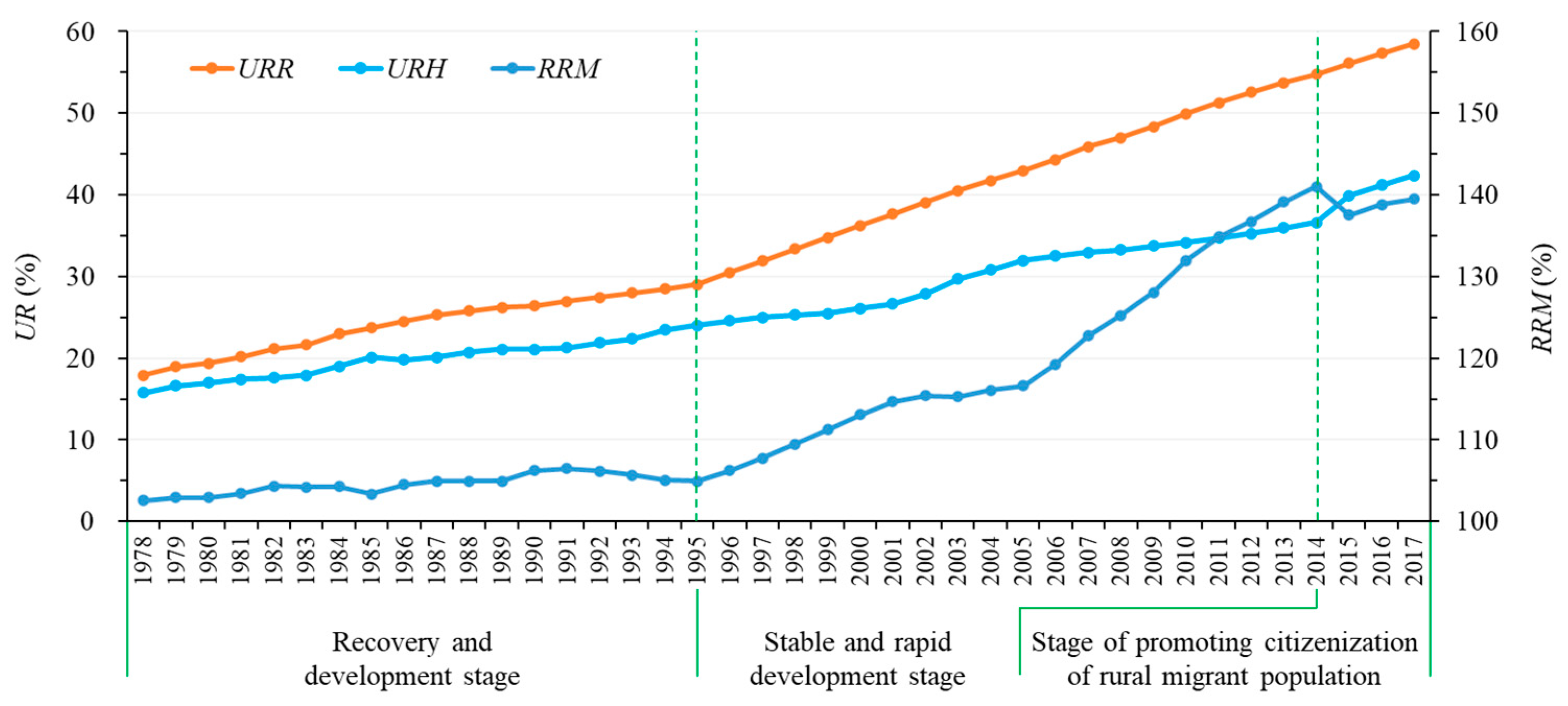


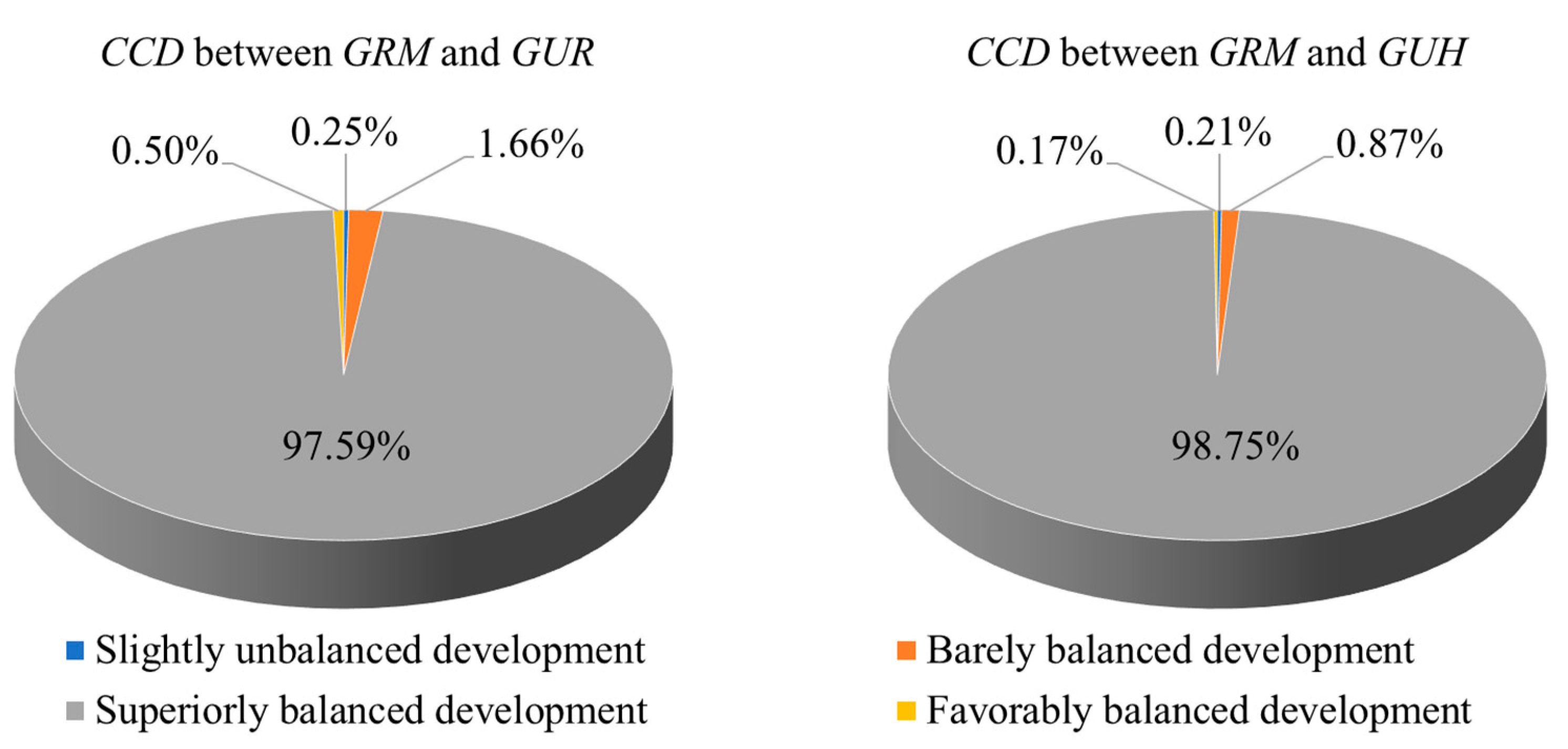
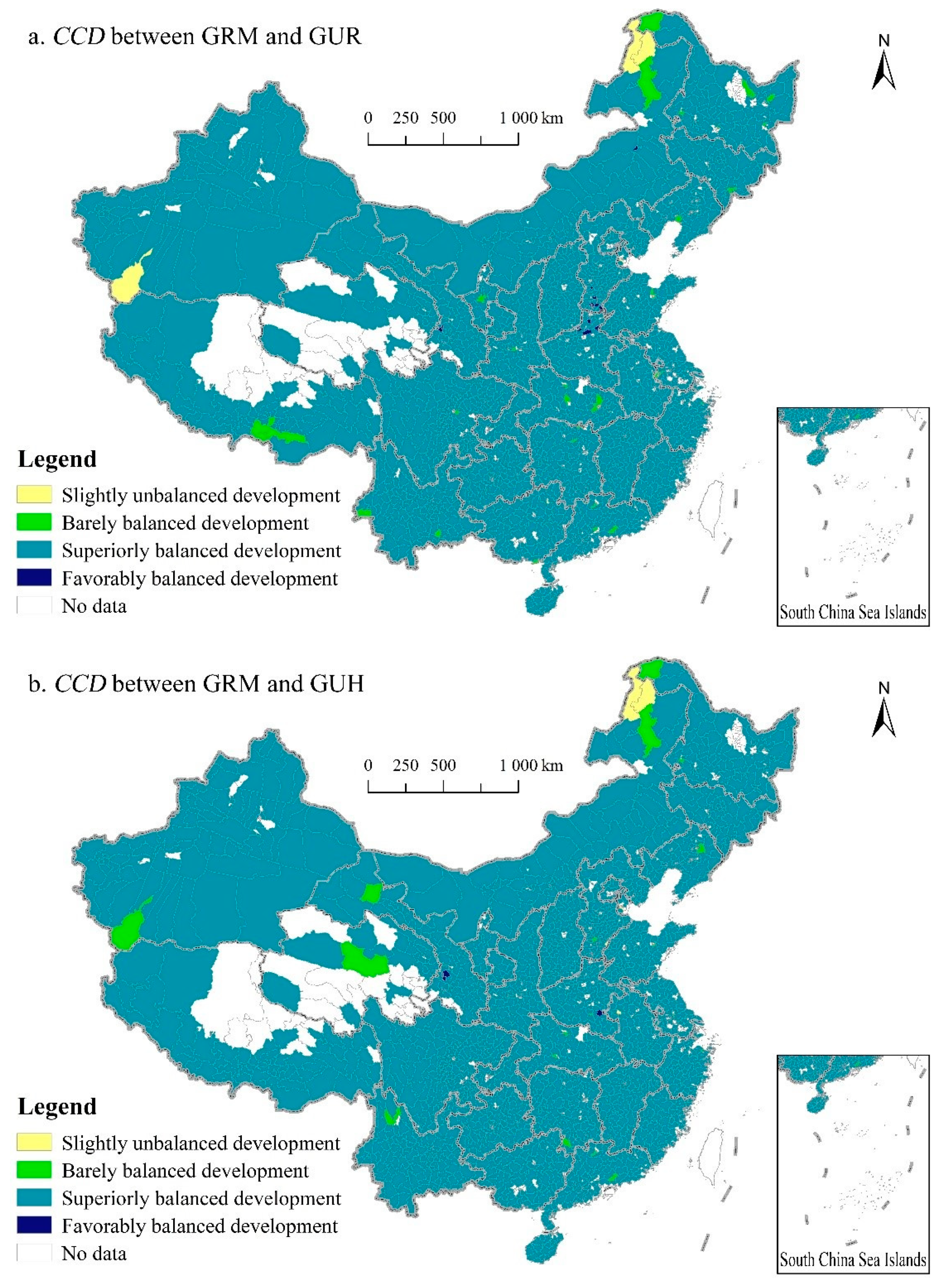
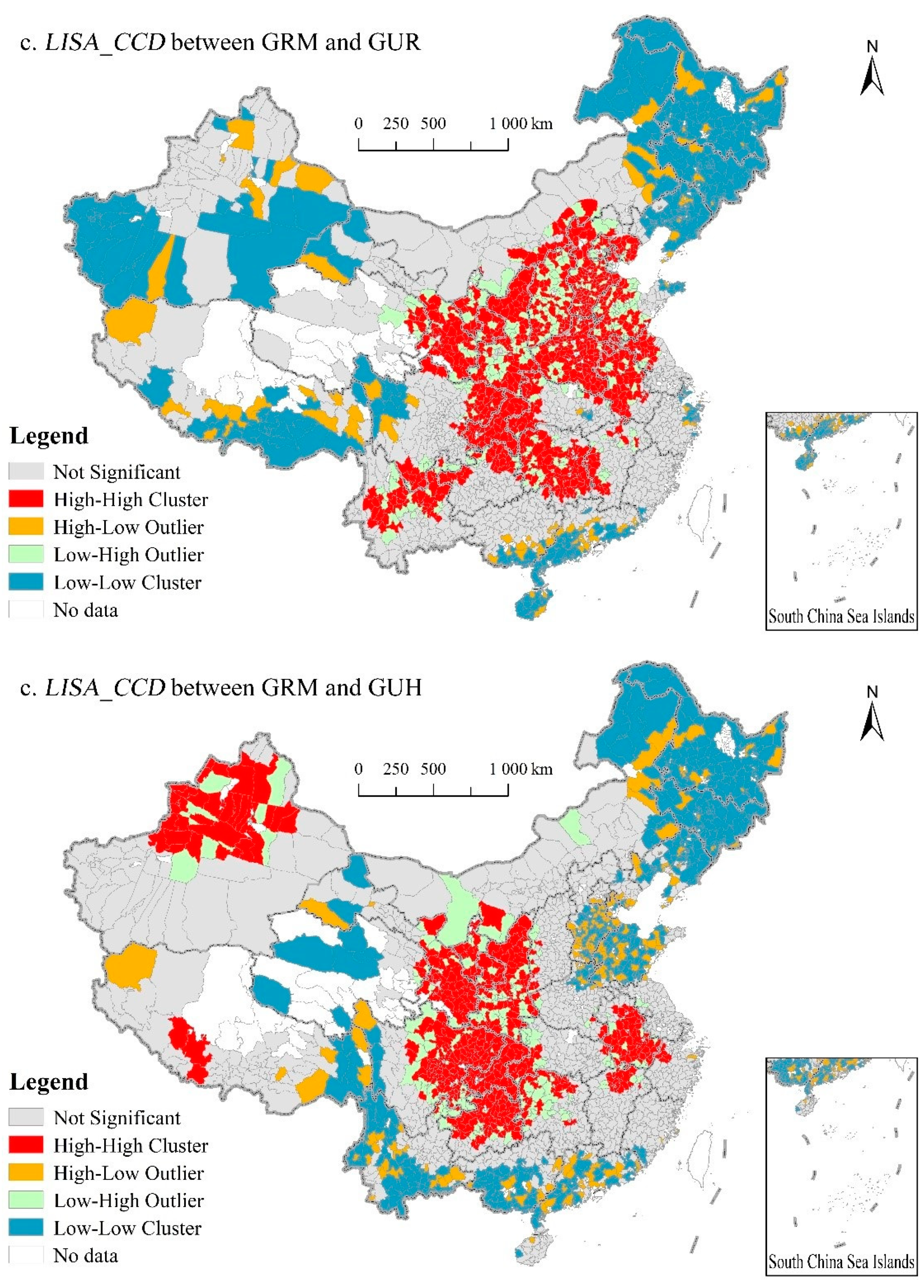
| Type | Unbalanced Development | Transitional Development | Balanced Development | |||
|---|---|---|---|---|---|---|
| Subtype | Seriously Unbalanced Development | Moderately Unbalanced Development | Slightly Unbalanced Development | Barely Balanced Development | Superiorly Balanced Development | Favorably Balanced Development |
| D | 0 < D ≤ 0.2 | 0.2 < D ≤ 0.4 | 0.4 < D ≤ 0.5 | 0.5 < D ≤ 0.6 | 0.6 < D ≤ 0.8 | 0.8 < D ≤ 1.0 |
| Grade | Eastern China | Central China | Western China | Northeastern China | Total | |
|---|---|---|---|---|---|---|
| GRM (Average annual growth rate of the ratio of migrant population) | (−34.00%, −5.00%) | 2.40% | 1.67% | 1.40% | 6.16% | 2.14% |
| (−5.00%, 0.00%) | 11.52% | 5.33% | 11.52% | 21.33% | 10.85% | |
| (0.00%, 5.00%) | 80.00% | 88.33% | 83.17% | 67.30% | 82.25% | |
| (5.00%, 10.00%) | 4.80% | 4.33% | 3.41% | 1.90% | 3.86% | |
| (10.00%, 41.00%) | 1.28% | 0.33% | 0.50% | 3.32% | 0.90% | |
| GUR (Average annual growth rate of the urbanization rate of residential populations) | (−23.00%, 0.00%) | 23.10% | 18.12% | 14.75% | 41.49% | 20.59% |
| (0.00%, 5.00%) | 42.86% | 33.19% | 42.62% | 52.48% | 41.33% | |
| (5.00%, 10.00%] | 22.56% | 34.93% | 31.53% | 6.03% | 27.34% | |
| (10.00%, 20.00%) | 10.28% | 12.32% | 10.32% | 0.00% | 9.75% | |
| (20.00%, 36.00%) | 1.20% | 1.45% | 0.77% | 0.00% | 0.98% | |
| GUH (Average annual growth rate of the urbanization rate of hukou-registered populations) | (−21.00%, −5.00%) | 1.07% | 0.72% | 0.75% | 0.71% | 0.83% |
| (−5.00%, 0.00%) | 32.18% | 24.49% | 19.42% | 37.94% | 25.98% | |
| (0.00%, 5.00%) | 63.15% | 68.26% | 67.17% | 59.57% | 65.59% | |
| (5.00%, 10.00%) | 3.20% | 5.65% | 11.44% | 0.71% | 6.71% | |
| (10.00%, 21.00%) | 0.40% | 0.87% | 1.22% | 1.06% | 0.90% |
© 2020 by the authors. Licensee MDPI, Basel, Switzerland. This article is an open access article distributed under the terms and conditions of the Creative Commons Attribution (CC BY) license (http://creativecommons.org/licenses/by/4.0/).
Share and Cite
Guo, Y.; Qiao, W. Rural Migration and Urbanization in China: Historical Evolution and Coupling Pattern. Sustainability 2020, 12, 7307. https://doi.org/10.3390/su12187307
Guo Y, Qiao W. Rural Migration and Urbanization in China: Historical Evolution and Coupling Pattern. Sustainability. 2020; 12(18):7307. https://doi.org/10.3390/su12187307
Chicago/Turabian StyleGuo, Yuanzhi, and Weifeng Qiao. 2020. "Rural Migration and Urbanization in China: Historical Evolution and Coupling Pattern" Sustainability 12, no. 18: 7307. https://doi.org/10.3390/su12187307
APA StyleGuo, Y., & Qiao, W. (2020). Rural Migration and Urbanization in China: Historical Evolution and Coupling Pattern. Sustainability, 12(18), 7307. https://doi.org/10.3390/su12187307





